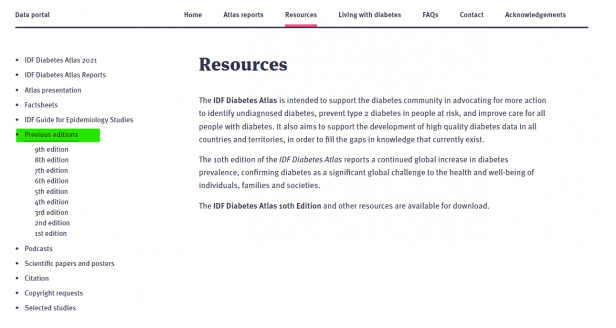International Diabetes Federation: Difference between revisions
No edit summary |
Kexin.Shang (talk | contribs) |
||
| (3 intermediate revisions by 2 users not shown) | |||
| Line 3: | Line 3: | ||
= Instructions on pulling IDF data = | = Instructions on pulling IDF data = | ||
The current update came from International Diabetes Federation's Diabetes Atlas; | The current update came from International Diabetes Federation's Diabetes Atlas; https://diabetesatlas.org/ | ||
Step 1 access https://diabetesatlas.org/resources/ | |||
Step 2 access the various editions of the atlas and gather data from pdf files. | |||
[[File:Image IDF 1.png|none|thumb|616x616px]] | |||
2014, 2015 and 2040 were added for prevalence of diabetes | Prevalence of diabetes ('''SeriesHealthDiabetesPrev%'''): 2014, 2015 and 2040 were added for prevalence of diabetes. The data for 2014 came from an atlas poster for 6th edition and all other data came from a tool on the site. | ||
2015 and 2040 were added for the prevalence of impaired glucose intolerance. | Prevalence of impaired glucose intolerance ('''SeriesHealthIGTPrev%'''): 2015 and 2040 were added for the prevalence of impaired glucose intolerance. | ||
These were national prevalences and not age adjusted. All this data can be located in the 5th, 6th and 7th edition of the Atlas. | |||
== Notes for Sept. 2024 Updates == | |||
=== '''SeriesHealthDiabetesPrev%''' === | |||
Update 2017, 2019, 2021 from 8th, 9th, and 10th Edition. | |||
=== '''SeriesHealthIGTPrev%''' === | |||
Only find "Age-adjusted comparative prevalance" from https://diabetesatlas.org/data/en/indicators/2/. | |||
The data could be found in 6th edition. | |||
[[File:Image idf 2.png|none|thumb|486x486px]] | |||
However, it was not accessable from 7th edition in pdf. | |||
No actual update. | |||
=== [https://diabetesatlas.org/faqs/ What is the difference between prevalence and age-adjusted comparative prevalence in the IDF Diabetes Atlas?] === | |||
National or regional prevalence is the actual percentage of the adult population (20-79 years) in a country or region that has diabetes. It is calculated by taking the estimated number of cases in adults and dividing by the total population in adults. The national prevalence should be used when reporting statistics for just one country or region, or when the statistics being reported are not for comparison. | |||
Age-adjusted comparative prevalence, also referred to as comparative prevalence, is the prevalence calculated by adjusting to the age structure of a standard population. In the ''IDF Diabetes Atlas 10th Edition'', the standard population is the UN population for 2021, 2030 or 2045. Adjusting rates is a way to make fairer comparisons between groups with different distributions. Age-adjusted rates are rates that would have existed if the population under study had the same age distribution as the “standard” population. | |||
Latest revision as of 17:50, 20 September 2024
The International Diabetes Federation (IDF) is an umbrella organization of over 230 national diabetes associations in 170 countries and territories. It represents the interests of the growing number of people with diabetes and those at risk. The Federation has been leading the global diabetes community since 1950.
Instructions on pulling IDF data
The current update came from International Diabetes Federation's Diabetes Atlas; https://diabetesatlas.org/
Step 1 access https://diabetesatlas.org/resources/
Step 2 access the various editions of the atlas and gather data from pdf files.
Prevalence of diabetes (SeriesHealthDiabetesPrev%): 2014, 2015 and 2040 were added for prevalence of diabetes. The data for 2014 came from an atlas poster for 6th edition and all other data came from a tool on the site.
Prevalence of impaired glucose intolerance (SeriesHealthIGTPrev%): 2015 and 2040 were added for the prevalence of impaired glucose intolerance.
These were national prevalences and not age adjusted. All this data can be located in the 5th, 6th and 7th edition of the Atlas.
Notes for Sept. 2024 Updates
SeriesHealthDiabetesPrev%
Update 2017, 2019, 2021 from 8th, 9th, and 10th Edition.
SeriesHealthIGTPrev%
Only find "Age-adjusted comparative prevalance" from https://diabetesatlas.org/data/en/indicators/2/.
The data could be found in 6th edition.
However, it was not accessable from 7th edition in pdf.
No actual update.
What is the difference between prevalence and age-adjusted comparative prevalence in the IDF Diabetes Atlas?
National or regional prevalence is the actual percentage of the adult population (20-79 years) in a country or region that has diabetes. It is calculated by taking the estimated number of cases in adults and dividing by the total population in adults. The national prevalence should be used when reporting statistics for just one country or region, or when the statistics being reported are not for comparison.
Age-adjusted comparative prevalence, also referred to as comparative prevalence, is the prevalence calculated by adjusting to the age structure of a standard population. In the IDF Diabetes Atlas 10th Edition, the standard population is the UN population for 2021, 2030 or 2045. Adjusting rates is a way to make fairer comparisons between groups with different distributions. Age-adjusted rates are rates that would have existed if the population under study had the same age distribution as the “standard” population.

